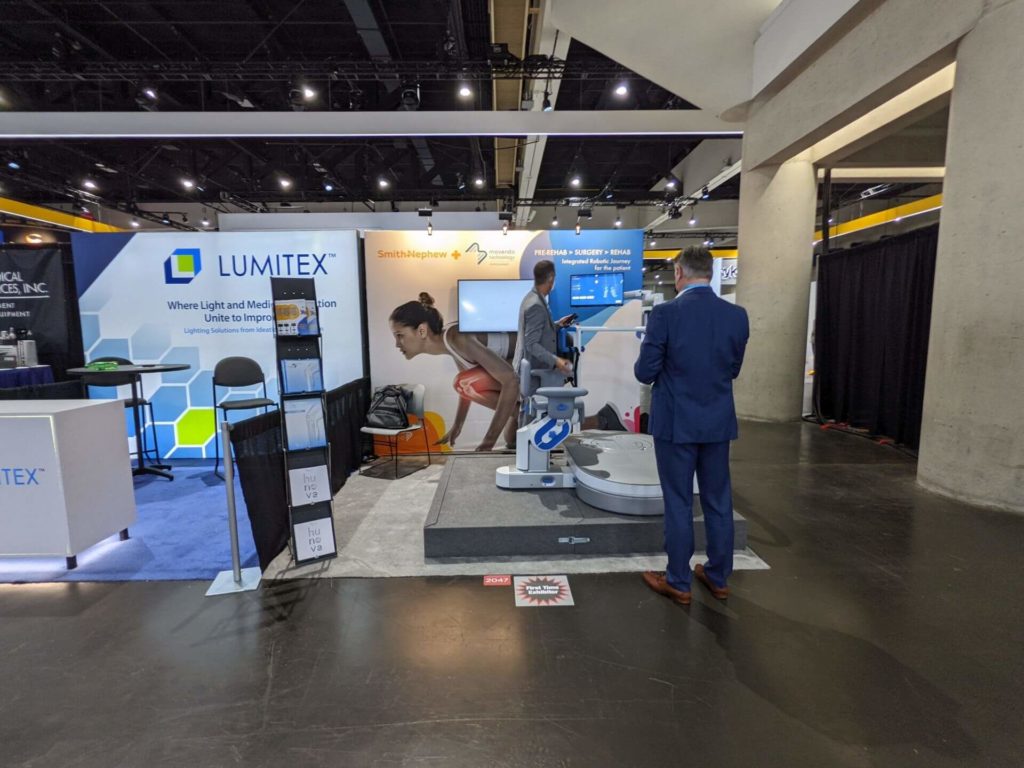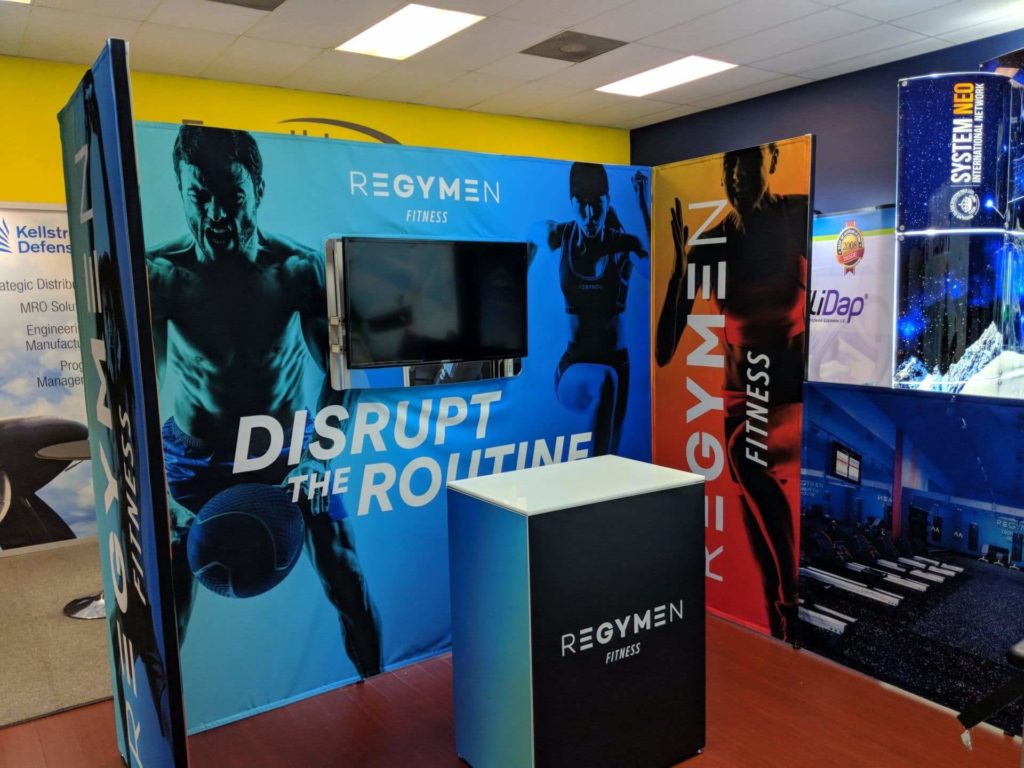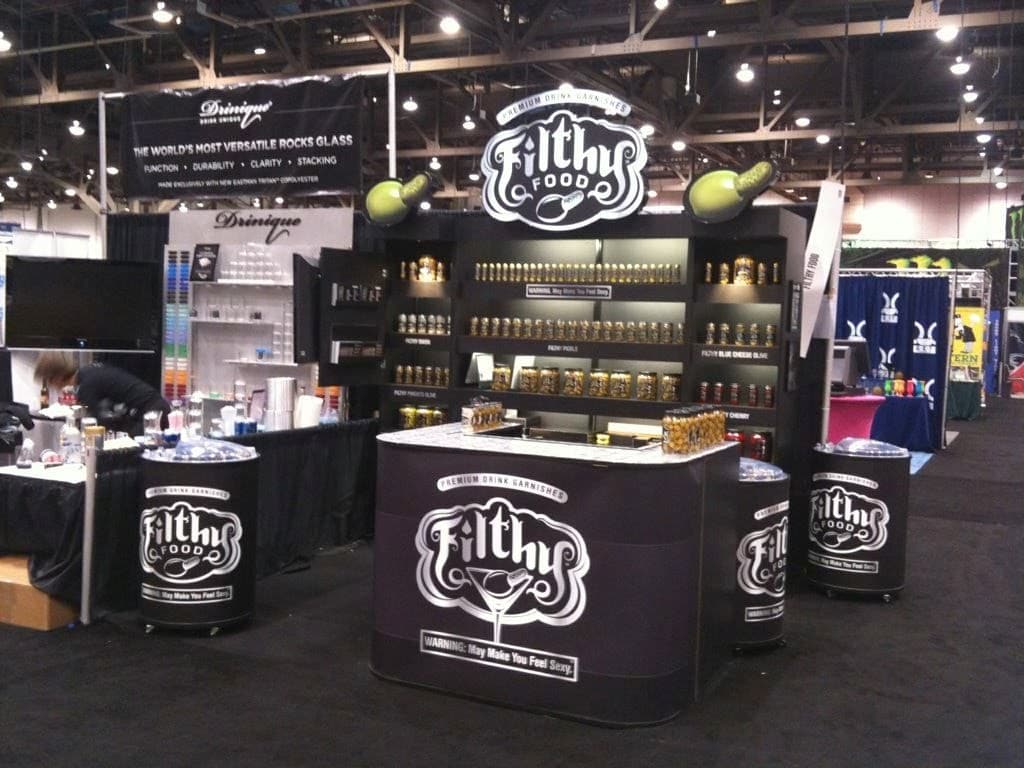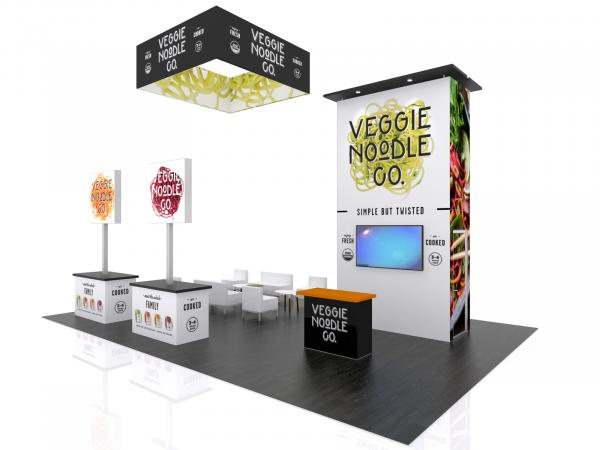💡 In this guide, you will learn how to plan a trade show.
Planning a trade show can be an intimidating prospect. Whether you’ve done it before or are just starting, there’s no denying that organizing a successful event requires careful planning and attention to detail. But with the right preparation and guidance, anyone can learn how to plan a great trade show.
In this trade show planning guide, we’ll cover everything you need to know about creating an unforgettable tradeshow experience for your attendees.
So let’s get started!
❗ Are you new to trade shows? Learn how to prepare for your first trade show.
Benefits Of Attending A Trade Show
Attending a trade show can be an invaluable experience for your business. It provides exposure to your potential customers and partners and allows you to network with industry professionals who may have valuable advice or resources that can help your business succeed.
Here are some of the benefits of attending a tradeshow:
- Making connections with others in your field, including potential clients or vendors, learning more about the competition, and building relationships with knowledgeable people in your industry
- Gaining access to new products and services that you may not have otherwise known about
- Discovering new opportunities to expand your product line or services
- Generating publicity for your business through media outlets
Attending a trade show provides numerous benefits for your business, from making connections to discovering new products and services. It is an excellent opportunity for your business to learn from one another, gain insight into recent market trends, and generate publicity for your brand.
How to Plan a Trade Show
Planning for a trade show can be an overwhelming experience, but it doesn’t have to be. With the right knowledge and tools, you’ll be able to pull off your event with ease.
When preparing for a trade show event, it’s crucial to create a timeline of tasks so that everything gets done in time. Having deadlines allows you to stay organized and makes sure nothing falls through the cracks during the planning process.
Here are the essential steps for planning for a trade show and the importance of each step:

Preparation for your Tradeshow
Knowing how best to prepare yourself beforehand so that you can get the most out of participating in a tradeshow exhibit is key to a successful trade show.
Here are several steps you must take before the actual event takes place:
Step 1: Establish Your Goals
Before you plan a trade show, it’s essential to establish why you’re doing so. What are your goals? You’ll need to know what you want to accomplish from attending the trade show and how to use this opportunity for maximum benefit.
Here are four ways that having clear objectives will help make your event successful:
- Gain exposure
Attending a trade show is one of the best opportunities to gain visibility in front of potential customers or partners.
- Showcase Products/Services
A well-planned booth gives you space to demonstrate your company’s offerings, whether physical goods or services.
- Network with Industry Contacts
Events like these offer time and place to meet people who may become valuable business connections later.
- Collect customer feedback
Surveys conducted at trade shows provide invaluable insight into what current and prospective customers think about your product or service offering.
Setting realistic goals ahead of time ensures that your investment in attending the trade show pays off.
❗ Check our trade show guide.
Step 2: Research The Trade Show
Now that you have established your goals for the trade show, it’s time to research which shows are the best fit.
Here are the steps you should take and things you should research on:
- Decide whether to attend a local or regional show based on your goals. Local events provide more face-to-face contacts and visibility, while regional shows are more cost-effective and draw attendees with similar interests.
- Take time to learn about the exhibitors attending each show and their product offerings. This information can help you determine which shows make sense based on the type of buyers present at any given event.
- Research potential vendors in advance to determine which ones are close to yours and may not be direct competitors. This can help you decide which shows may be most successful and avoid investing too much money in attending one.
- Check if extra amenities, such as chairs or tables, need to be rented separately before signing up and budgeting for them.
- Start networking online and with other exhibitors participating in the same show. Exchanging contact information helps build relationships between competitors and allows everyone involved to develop mutually beneficial partnerships during the lead-up period, which could increase sales before opening day.
With all this knowledge under your belt, it’s time to create a budget that fits within your means yet ensures success at every show attended.
❗ Here is our guide on what to wear to a trade show.
Step 3: Create A Budget
Creating a budget for your trade show is essential. It would be best if you planned out all the expenses of having an event like this, including labor costs and materials, as well as any additional services you may require.
Here are some helpful tips for creating a budget for your tradeshow planning:
- Make a list of what you need for the show and calculate the costs. Set aside money from each paycheck to cover the payments. Look into sponsorships or grants to reduce costs.
- Create a realistic budget for your event, and use software programs such as QuickBooks or Mint to track spending and stay organized. Adhere to the budget to avoid accumulating debt.
With careful planning and tracking, there’s no reason why your trade show shouldn’t go off without a hitch!
Step 4: Develop A Marketing Plan
Now that you have your budget set, it’s time to develop a plan for marketing the event. It may sound daunting, but creating a successful marketing strategy is easily achievable with some research and planning.
Here are three key elements to consider when creating your trade show marketing plan:
1. Identify Your Target Audience – Who do you want to attend your trade show? Do they know about the industry, or will you need to educate them? Once you identify who should be attending, create a list of target companies and individuals within those companies so you can market more efficiently.
2. Find The Right Platforms To Reach Your Audience – You’ll need to find out which platforms your potential attendees use, from social media accounts (Facebook, Instagram, etc.) to email campaigns, brochures, and print ads. Knowing where people go for information daily will help ensure maximum visibility of your trade show details.
3. Create Engaging Content For Each Platform – Different audiences respond differently depending on the platform used for advertising. Make sure each piece of content matches the style and format of its respective platform – particularly important when targeting different age groups or industries. Plus don’t forget to include critical information such as registration deadlines and any special offers available at the event.

Execution
Once the critical details of your trade show have been organized, it’s time to move on to the execution phase. This is where all those big ideas turn into tangible results.
To get started, you’ll need a timeline for when tasks should be completed and staff assigned to take on each task. It’s important to keep everyone involved in this process well-informed as changes occur so that there are no surprises come crunch time.
❗ Check our guide on how to sell at a trade show and our tips on selling at a trade show.
Here are the necessary steps you should take on the Execution phase:
Step 5: Promote Your Trade Show Presence
Getting the word out about your trade show presence is essential to success. You want to ensure your target audience knows you’ll be there and what they can expect when they visit.
Here are some tips for promoting a successful trade show experience:
- Reach out via email, social media, and any other channels where potential customers might see it. Make sure to include all necessary information, such as the date and location of your booth. Be creative with these promotions so that people will remember them.
- Create promotional materials like flyers or postcards with appealing visuals and an easy-to-read format. Put these materials in local businesses, coffee shops, schools, libraries, etc. Anywhere potential customers can find them.
- Look into paid advertising options like print ads in local newspapers or magazines or online campaigns on websites related to your product/service offering. This is especially beneficial if you have a limited marketing budget since it allows you to reach more people for less money than traditional forms of advertising.
These strategies should give you a good start when getting the word out about your upcoming trade show appearance. Take advantage of every opportunity available to get eyes on your brand before the event starts.
❗ Check our guide on how to make your trade show booth stand out.
Step 6: Train Your Booth Staff
Once you’ve determined who will staff your booth and their roles, it’s time to train them. Ensure they understand the trade show’s goals and how they can contribute to achieving those goals.
Here are the steps and things your staff should know about:
- Know your company’s products or services thoroughly so that they can answer any questions from potential clients.
- Staff should also be aware of competitor offerings and have a plan to address customer objections.
- Staff should also review proper etiquette and protocol when interacting with customers at the booth and any other rules or regulations related to the event itself.
- Ensure all team members know about any special offers or promotions during the show so they can inform attendees accordingly.
With everyone trained adequately before arriving at the show, your team should be ready to go!
During The Trade Show
Now that you’ve trained your booth staff, it’s time to turn your attention to the trade show. To make sure this event goes smoothly, there are several key steps you need to take:
Step 7: Connect With Prospects
Once you’ve planned and set up the trade show, it’s time to connect with prospective customers. The key is to make a strong first impression and tell your prospects why they should choose your business over others.
❗ Here are our trade show attendee tips.
Here are the tips for connecting with prospects:
- Start by introducing yourself and discussing what makes your product or service unique. If applicable, ensure you have plenty of materials, including brochures, pamphlets, and samples.
- Listen carefully to understand their needs so that you can tailor your pitch appropriately.
- Be prepared to answer any questions that may come up during the conversation.
- Ask them questions yourself to get an idea of how your products might fit into their lives.
- Show enthusiasm for what you’re offering; be passionate about its potential benefits!
- Follow industry news closely to stay informed on trends and current events related to your field.
- Attend seminars or webinars hosted by leaders in your niche and use social media platforms like Twitter, LinkedIn, Facebook, and Instagram to reach out to other professionals in the space.
- Collect contact information from those who express interest in working with you afterward; follow up quickly via email or phone once the show ends.
With thoughtful preparation and meaningful connections made throughout the process, participating in a trade show can significantly benefit your business looking for new opportunities.
❗ Don’t miss our trade show giveaway ideas.
Step 8: Follow Up On Leads
Once the trade show is over, it’s important to follow up on leads. Start by sending out a thank you email to anyone who stopped and talked about your product or service. This will help build relationships with potential customers and ensure they remember you.
Here are tips for following up on your leads:
- Take note of any key contacts made during the event and save their details for potential business partners and future marketing campaigns.
- Create a folder or library with all materials from each trade show booth to allow everyone to review the event and identify areas for improvement.
- Save data collected from visitors, such as contact information, feedback surveys, and other relevant documents, for later analysis.
- Ask staff members for feedback on their experiences at the trade show. Use their answers to determine which strategies should be kept and which should be improved for the next event. This feedback will help you gather customer insights and increase your chances of success.

Step 9: Gather Feedback
Now that you’ve followed up on all those leads and your trade show is over, it’s time to gather feedback. This kind of data can be incredibly valuable for planning future events and refining marketing strategies.
Here are some things to consider when gathering feedback:
- Ask attendees about their experience:
- What did they enjoy?
- Were there any areas of improvement?
- Reach out to vendors, sponsors, and partners who participated in the event:
- How was their overall experience?
- Was traffic or engagement better than expected?
Remember to ask yourself what went well and what could be improved upon. After all, you were the driving force behind this event. It’s important to reflect on how everything went so you can use the information gathered from attendees, vendors, and yourself going forward.
By doing this, you’ll become more knowledgeable each time a new trade show comes around and will have an even better outcome moving forward.
❗ Don’t miss our complete trade show checklist.
Wrapping Up
The key to a successful trade show is planning. Following the trade show planning template above ensures your business is well-prepared and ready for success. Attending trade shows can be an invaluable tool for any business as it allows you to interact with potential customers and learn more about what they need from your product or service.
Overall, if you plan ahead and have clear goals, a trade show can be a potent marketing tool for growing your business. So why wait? Start your trade show planning and get organized today!
Learn more about trade show best practices:
- Discover essential trade show tips for exhibitors to maximize your booth’s potential.
- Learn more about how to collect leads at a trade show.
- Explore effective strategies on how to display clothing at a trade show to boost visitor engagement.
- Not sure how to display products at a trade show? Read our guide.
- Implementing engaging activities is essential for learning how to attract people to your booth.
- Explore strategies on how to get exhibitors for a trade show.
- Read more how to have a successful trade show booth.
- Discover how to make your trade show booth stand out with these innovative design tips!
- Conducting thorough research plays a crucial role in gaining insights on how to effectively prepare for a trade show.
- Learn how to sell at trade shows to maximize your business’s potential and outreach.
- Explore our comprehensive manual on establishing a booth at a trade show.
- Explore the top recommendations for ensuring a smooth and successful shipment to a trade show.
- Many businesses boost their revenue by selling at trade shows. Read our blog post.
- Here are some trade show attendee tips to help you make the most of your experience.
- Discover our comprehensive trade show best practices guide.
- Don’t forget to review the trade show checklist before the event to ensure everything is in order.
- Here are some trade show exhibitor tips to help you succeed at your next event.
- Interested in finding unique trade show giveaways? Take a look at our range of promotional items!
- Here are some trade show giveaway ideas to attract visitors to your booth.
- What makes a good trade show booth? Find out in our latest blog post.
- Looking for trade show banner ideas? Check out our latest design inspirations!
- Discover our trade show attire recommendations in our comprehensive guide.
- Are you interested in what type of promotion takes place at trade shows? Explore this topic.
- Why attend trade shows? Discover the best arguments.
- Why do exhibitors attend trade shows? Read more on our blog.
- Discover the answer to this common question: Why exhibit at a trade show?
- Learn more about why are trade shows important.

It’s in the name! Everything Tradeshows is your one-stop shop for all things trade shows, including booth purchases, booth rentals, and complete brand management services. Ready to get started? Have questions? Get in touch by calling us at (954) 791-8882 or by filling out the form below. We can’t wait to hear from you!








